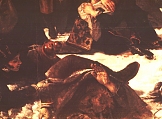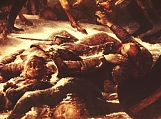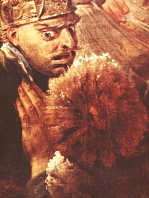The Napoleonic Wars |
The Napoleonic Wars |
France declared war against Austria and Prussia in April of 1792 and by March of the following year France was at war with most of Europe. Because there was no standing army, every eligible male was potentially a soldier. With an entire nation at war, it was important to rally support. Artists came to the support first of the revolution and later of Napoleon. The most important battle painter of this period was Antoine-Jean Gros, who became the official chronicler of Napoleon's military campaigns. Although Gros was interested in historical realism (correct uniforms, portrait faces, and accurate settings), his battle paintings essentially glorify Napoleon.
Details of the foreground of Napoleon at Eylau | ||
 |
 |
 |
All images marked MAS were photographed on location by Mary Ann Sullivan. All other images were scanned from other sources or downloaded from the World Wide Web; they are posted on this password-protected site for educational purposes, at Bluffton College only, under the "fair use" clause of U.S. copyright law.